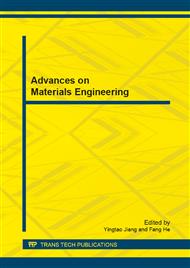[1]
F. Carinei, A. Piattelli, G. Stabelini, et a1. : Calcium sulfate: analysis of MG63 osteoblast-like cell response by means of a microarray technology, J Biomed Mater Res B Appl Biomater Vol. 71(2) (2004), pp.260-267.
DOI: 10.1002/jbm.b.30133
Google Scholar
[2]
J. Q. Wei, X. Z. Tian, B. X. Zhong: Effect of calcium sulfate on gene expression in differentiation of human BMSCs into osteoblasts, Chinese Journal of Experimental Surgery Vol. 27(11) (2010), pp.1589-1591.
Google Scholar
[3]
B. Bose: Results of a calcium sulfate bone graft substitute used to promote posteerolateral lumbar spinal fusion, Neurosurgery Quarterly Vol. 13(4) (2003), pp.251-256.
DOI: 10.1097/00013414-200312000-00003
Google Scholar
[4]
C.M. Kelly, R. M. Wilkins, S. Gitelis,et a1.: The use of a surgical grade calcium sulfate as a bone graft substitute: results of a multicenter trial, Clin Orthop Relat Res. Vol. 382 (2001), pp.42-50.
DOI: 10.1097/00003086-200101000-00008
Google Scholar
[5]
M. Bohner: New hydraulic cements based on α-trialcium phosphate-calcium sulfate dehydrate mixture, Biomaterials Vol. 25(4)(2004), pp.741-749.
DOI: 10.1016/s0142-9612(03)00573-8
Google Scholar
[6]
M. Wei, M. Uchida, H. M. Kim, et a1. : Apatite-forming ability of calcium-containing titania, Biomaterials Vol. 23(2002), p.167.
DOI: 10.1016/s0142-9612(01)00092-8
Google Scholar
[7]
T. Kokubo, H. Kushitani, S. Sakka, et a1. : Solution able to reproduce in vivo surface-structure change in bioactive glass ceramic A-W, J Biomed Mater Res Vol. 24(1990), p. 72l-734.
DOI: 10.1002/jbm.820240607
Google Scholar
[8]
J. X. Xie, in: Application of infrared spectroscopy in organic chemistry and medicinal chemistry , edtied by Science Press, Beijing (1987).
Google Scholar
[9]
F. S. L. Rubia, L. V. Wander: Study of the influence of some DCCAs on the structure of sol-gel silica membranes, Journal of Non-crystalline solids. Vol. 330(1-3) (2003), pp.216-225.
DOI: 10.1016/j.jnoncrysol.2003.07.001
Google Scholar
[10]
A.S. Povarennykh: The use of infrared spectra for the determination of minerals: Amer. Mineral. Vol. 63(1978), pp.956-959.
Google Scholar
[11]
V. C. Farmer, in: Infrared spectroscopy of mineral, edtied by Ying Fupu, Etc., translated. Science Press, Beijing (1982).
Google Scholar
[12]
F. Hiromu: Absorption phenomenon and recovery technique of heavy mental ions by clay minerals: Waseda Daigaku Riko- gaku kenkyusho Hokoku. Vol. 89(1980), pp.88-91.
Google Scholar
[13]
B. X. Gu, L. M. Wang, L. D. Minc, et al.: Temperature effects on the radiation stability and ion exchange capacity of smectites, Journal of Nuclear Materials Vol. 297(2001), pp.345-354.
DOI: 10.1016/s0022-3115(01)00631-6
Google Scholar
[14]
G. Bell, J. Bensted, F. P. Glasser: Characterization of hydrothermally treated calcium silicate and oil well cement hydration productions, Advance Cement Research Vol. 2(6) (1989), p.61.
DOI: 10.1680/adcr.1989.2.6.61
Google Scholar
[15]
Y. P. Guo, H. X. Tang, D. C. Jia: Deposition of Plate-Like Apatite on Nacre Surfaces and Its in Vitro Bioactivity, Rare Metal Materials and Engineering Vol. 38(z2)(2009), pp.834-837.
Google Scholar
[16]
T. Wan, Y. H. Yan, Y. J. Zhu: A study of bone-like apatite formation on PMMA/ HA-GF composites surface in SBF, Functional Materials Vol. 5(38)(2007), pp.846-852.
Google Scholar
[17]
L. M. Dong, C. Wang, J. M. Tian: Study on the structure analysis and forming mechanism of bone-like apatite, Functional Materials Vol. 35(z1) (2004), pp.2397-2400.
Google Scholar
[18]
X. F. Chen , Y. J. Wang , N. Zhao et al.: Acta Material Research Vol. 17(3)(2003), pp.266-275.
Google Scholar


